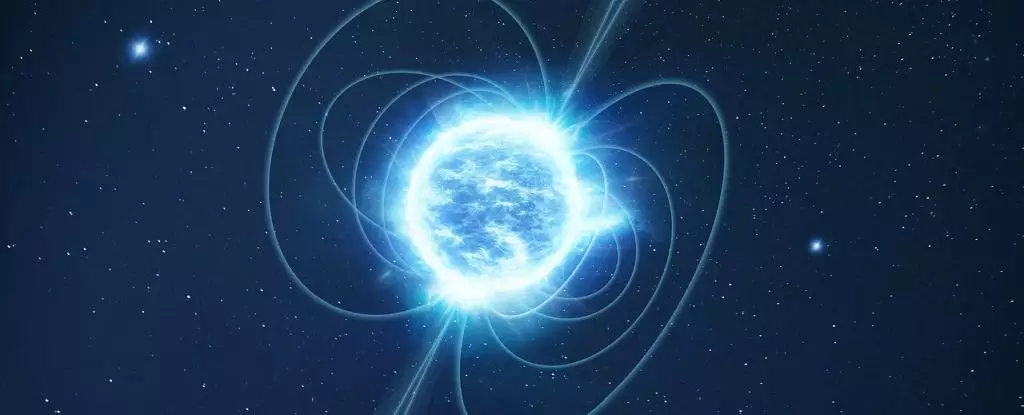At the very edges of our galaxy lies a celestial wonder that has both intrigued and baffled astronomers: SGR 0501+4516, a magnetar that has recently been thrust into the spotlight due to groundbreaking observations. In the vast cosmic arena, these neutron stars represent one of the most extreme states of matter, with magnetic fields that dwarf even those of regular neutron stars by a factor of a thousand. Yet, despite their significance in our understanding of stellar evolution, the birth mechanisms of magnetars remain largely shrouded in mystery. The latest findings, derived from meticulous observations made by the Hubble and Gaia telescopes, cast serious doubt over previous assumptions regarding their formation.
Breaking Down the Birth of a Magnetar
Traditionally, astrophysicists theorized that magnetars, as a subclass of neutron stars, originate from core-collapse supernovae. This process typically ensues when a massive star exhausts its nuclear fuel, leading to a catastrophic implosion followed by a violent explosion. Such events leave behind remnants that provide key insights into the star’s life cycle. The close proximity of SGR 0501+4516 to the supernova remnant HB9 had previously led researchers to believe they were intertwined; however, the new evidence suggests that their link is far more tenuous than once thought.
The extensive data analysis conducted by a team led by astronomer Ashley Chrimes revealed that SGR 0501+4516 exhibits a velocity and motion that cannot properly correlate with the remnants of HB9. Disturbingly for traditional theories, this suggests that the magnetar may either be significantly older than previously estimated or may not have originated from a supernova explosion at all.
Reconsidering Stellar Evolution
If SGR 0501+4516 doesn’t belong to the crowd of neutron stars birthed via supernova, what alternative genesis could explain its existence? One compelling hypothesis proposes that this magnetar could have arisen from the merger of two low-mass neutron stars or even a white dwarf star. This scenario posits that under certain conditions, a white dwarf—a star that has burned out most of its nuclear fuel—could accumulate mass from a binary companion star to a point that leads to catastrophic gravitational collapse.
Andrew Levan, an astronomer from Radboud University, explained that while a typical explosion would lead to the annihilation of the white dwarf, it’s theorized that in certain circumstances, the object could instead transform into a neutron star. If this is indeed how SGR 0501+4516 was formed, it may be the shining example of an alternative route to magnetar birth.
The Implications for Astrophysics
The implications of these findings are profound, not just for understanding SGR 0501+4516 but also for re-evaluating our models of stellar evolution as a whole. If magnetars can be birthed through mechanisms entirely dissimilar to the long-accepted model involving core-collapse supernovae, then astronomers must reassess their views on neutron star formation and the processes that govern their lifecycle. Essentially, the knowledge we thought we had regarding the life and death of stars may not be as secure as previously believed.
Moreover, SGR 0501+4516 stands as a beacon for the fewer-than-30 magnetars identified in the Milky Way that could hint at this alternative formation pathway. This potential paradigm shift encourages researchers to cast a wider net in their studies of stellar remnants, seeking not just the remnants of massive stars but looking at binary interactions that might yield completely new categories of stellar phenomena.
The Future of Magnetar Research
As scientific inquiry pushes further into the cosmos, it lays bare the complex and often confounding nature of our universe. The revelations surrounding SGR 0501+4516 encourage a sense of excitement about the vast unknowns yet to be decoded. The future of magnetar research promises to be dynamic, requiring innovative tools, and collaboration across disciplines. As we refine our observational capabilities and strengthen our computational models, the scientific community may reveal a richer tapestry of cosmic events than previously imagined.
The mystery of SGR 0501+4516 is not merely an academic puzzle; it is a microcosm of the larger quest to comprehend the intricate mechanisms that define our universe. With every discovery, we come closer to demystifying not just magnetars, but the very nature of stars themselves, their evolution, and the threads that connect them through the fabric of time and space. Each finding leads to new questions and new possibilities, underscoring a vital truth: in the vastness of the universe, mysteries are as plentiful as the stars themselves.


Leave a Reply